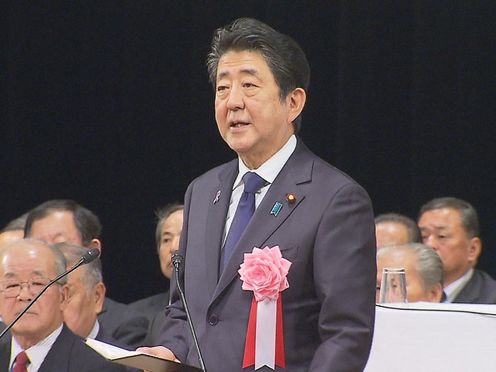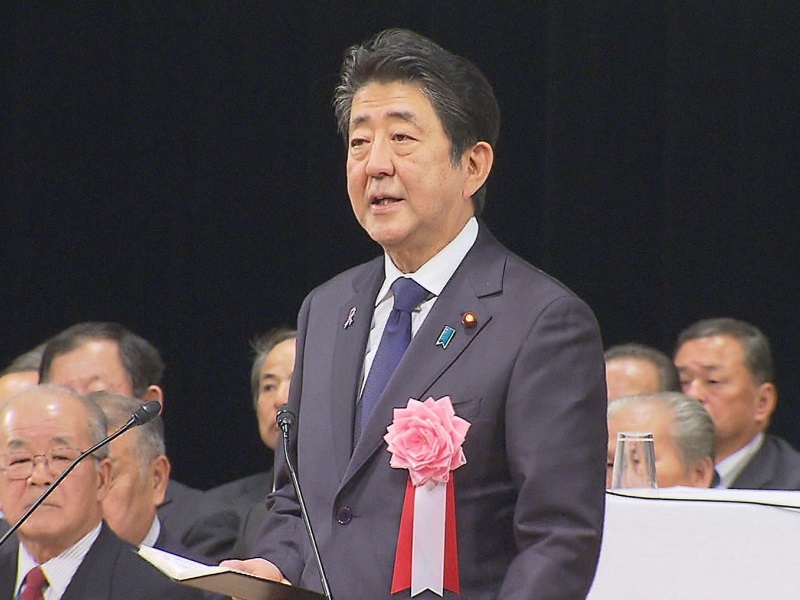Home > News > The Prime Minister in Action > November 2018 > National Convention of the Chairpersons of Town and Village Assemblies
The Prime Minister in Action
National Convention of the Chairpersons of Town and Village Assemblies
November 21, 2018
[Provisional Translation]
On November 21, 2018, Prime Minister Shinzo Abe attended the 62nd National Convention of the Chairpersons of Town and Village Assemblies held in Tokyo.
The Prime Minister said in his congratulatory address,
“I express my most heartfelt congratulations upon the successful opening of the 62nd National Convention of the Chairpersons of Town and Village Assemblies today.
I would also like to express my profound respect for the chairpersons of town and village assemblies, who work tirelessly every day for the development of local communities and the improvement of residents’ welfare as the closest representatives of the residents.
When I entered this venue today, I felt that there was considerably greater applause from this side of the hall. It turns out that they are from my hometown of Yamaguchi Prefecture. Next to them are attendees from Wakayama Prefecture, which is the hometown of Minister for Internal Affairs and Communications Ishida. Seated two sections behind Yamaguchi Prefecture are attendees from Aomori Prefecture, hometown of Speaker of the House of Representatives Tadamori Oshima. On this side we have the attendees from Hokkaido, hometown of President of the House of Councillors Chuichi Date. This is precisely the kind of consideration, as well as method of applying pressure, that only the National Association Chairpersons are capable of. I am renewing my resolve to maintain and develop this beautiful Japan, working together with all of you from the towns and villages that are maintaining the beauty of Japan.
There is no doubt that it is in the regions that opportunities can be found. It is important to create attractive regions that make young people feel this way and want to join them. Kawakami Village in Nara Prefecture, which is renowned for Yoshino cedar, is one of the villages that is experiencing serious depopulation. More than half of the Regional Vitalization Cooperation Volunteers who moved to this village from urban areas, with a strong desire to change their living environments and drawn by its appeal, settled down there after completing their term as volunteers. They are now active members of the community by operating eco-tours and farm stays, which take advantage of the local forests, a unique feature of the village, which help preserve water resources and are characteristic of the region. To spread this trend across the whole of Japan, we aim to provide strong support for U-turns (from one’s hometown in a local district to a city and back), I-turns (from one’s hometown in a local district to a different local district) and J-turns (from one’s hometown in a local district to a nearby city) by young people who feel that it is in the regions that opportunities can be found, including the expansion of the Regional Vitalization Cooperation Volunteers initiative. To maximize the unique appeals of each region, such as lush natural environments and distinctive regional specialties, we will exert every effort to provide a strong boost for the enthusiasm and unique creativity of the regions such as the 100-billion-yen Regional Revitalization Promotion Grant.
The Abe Cabinet adheres to its fundamental position that Japan will not have vitality unless its regions do raise the banner for regional revitalization, which enters its fifth year, higher than ever before.
This summer, various parts of Japan suffered severe damage in the wake of successive natural disasters, including the earthquake in the northern part of Osaka, the heavy rains in western Japan in July, Typhoon No. 21,* and the Hokkaido Eastern Iburi Earthquake. Using the supplementary budget, we will accelerate disaster recovery, and implement measures with the highest priority, such as safety measures for concrete walls to protect the lives of our children, and the installation of air-conditioning units in public elementary and junior high schools across Japan as a countermeasure to heatstroke. Furthermore, I have just instructed the commencement of work to formulate the second supplementary budget in order to meet the needs of our citizens. To further promote the building of safe communities, we will implement emergency measures intensively over the next three years for disaster prevention and disaster mitigation, as well as the building of national resilience, including the development of infrastructure in response to the rapidly changing weather conditions in recent years.
The greatest challenge facing Japan is the declining birthrate and the aging of society. We will tackle this challenge head-on, and advance reforms over the next three years to establish a social security system that can bring peace of mind to all generations, from children to the working generation and the elderly.
I would like to conclude my address on the occasion of the National Convention of the Chairpersons of Town and Village Assemblies by extending my best wishes for the continued progress of the National Association Chairpersons of Town and Village Assemblies, as well as the further success of everyone in attendance today.”
*Typhoon Jebi


